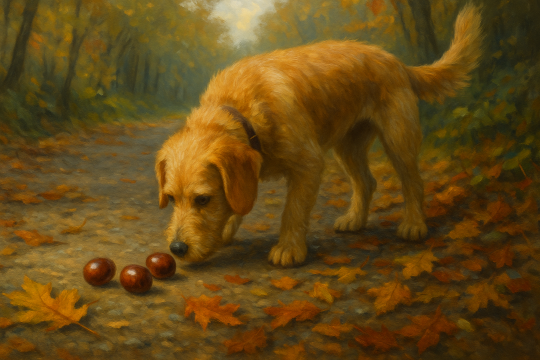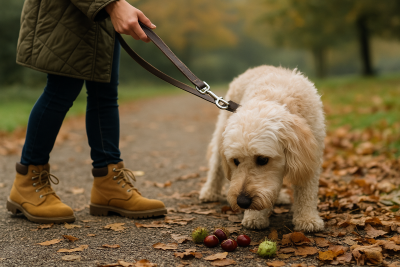
Is a Conker Poisonous to Dogs? The Autumn Danger Every Owner Should Know
Conkers on autumn walks: beautiful, but risky
The crunch of leaves, the chill in the air, the glint of glossy brown conkers scattered underfoot — autumn in the UK is made for long dog walks. But while we might enjoy the season’s colours, conkers can pose a hidden danger to dogs.
Each year, vets warn owners to stay cautious around these shiny seeds from the horse chestnut tree. They may look harmless, but a conker can be poisonous to dogs — and sometimes even cause choking or blockages. Here’s what you need to know to keep your dog safe this season.
Are conkers poisonous to dogs?

Yes — conkers are toxic to dogs. They contain a chemical called aesculin, found in both the nut and the tree’s leaves. Ingesting conkers can make dogs very ill, depending on the amount eaten and the size of the dog.
According to the Blue Cross and PDSA, aesculin can cause vomiting, diarrhoea, drooling, abdominal pain and tiredness. In severe cases, it can affect the nervous system and lead to tremors or collapse.
The toxicity is relatively mild compared to some plants, but the real risk lies in how dogs interact with conkers — chewing, swallowing, or playing fetch with them.
Why conkers are dangerous for dogs
Conkers present three main dangers:
- Poisoning – The aesculin compound irritates the stomach and intestines.
- Choking hazard – Their smooth, round shape makes them easy to lodge in the throat.
- Intestinal blockage – Even if swallowed safely, conkers don’t digest and can cause internal blockages requiring surgery.
Puppies and playful dogs are especially at risk because they love picking up interesting things with their mouths.
Symptoms to watch for
If your dog has been near conkers, look out for:
- Drooling or retching
- Vomiting or diarrhoea (sometimes with blood)
- Loss of appetite
- Restlessness or weakness
- A swollen or painful stomach
- Tremors or wobbliness in severe cases
Symptoms usually appear within a few hours but can take up to a day to develop.
What to do if your dog eats a conker
Don’t panic, but act quickly.
- Call your vet immediately. Tell them how many conkers were eaten and roughly when.
- Do not try to make your dog sick unless advised by a vet — this can make things worse.
- Keep a sample or photo of the conker to show the vet.
The RSPCA also recommends contacting a vet straight away if you suspect poisoning, even if your dog seems fine at first. Most dogs recover fully with prompt treatment, but blockages sometimes need surgery.
You can also call the 24-hour Animal PoisonLine (via VetHelpDirect) for professional guidance.
Are all parts of the horse chestnut tree toxic?
Yes — the leaves, flowers and bark all contain aesculin, but the conker itself poses the greatest risk because dogs are more likely to play with or swallow it.
Safe autumn alternatives
Autumn walks don’t have to be off-limits — just a little more mindful.
- Avoid playing fetch near horse chestnut trees.
- Bring your own ball or toy.
- Keep dogs on leads in conker-heavy areas.
- Check your garden if you have a horse chestnut tree nearby.
If you want to give your dog something seasonal to chew, opt for vet-approved toys or natural treats instead.
Turning autumn moments into art
If your dog loves bounding through fallen leaves (minus the conkers), that joy is worth celebrating. Many Dog Artists clients capture their pets in their favourite season through a hand-painted pet portrait — turning fleeting autumn walks into artwork that lasts a lifetime.
Each portrait is created in oil on canvas by artists such as Tom Lloyd and Sam Banks, using your dog’s photo as the reference. From Renaissance grandeur to modern minimalism, these bespoke pet portraits capture both personality and presence.
It’s a gentle way to remember your dog’s golden-hour adventures — without any risk of conkers involved.
🐾 FAQs
Can dogs play with conkers safely?
No. Even if they don’t swallow them, chewing can still release toxins or cause choking.
How many conkers are toxic to dogs?
Even one conker can cause stomach upset, especially in small dogs. Several can lead to poisoning or blockage.
What should I do if my dog swallows a conker whole?
Call your vet or Animal PoisonLine immediately — the sooner you act, the better.
What’s the difference between horse chestnuts and sweet chestnuts?
Sweet chestnuts (sold for roasting) are not toxic to dogs, though large amounts may still upset their stomach. Horse chestnuts — the conkers you find in parks — are the harmful ones.
Final thoughts
Conkers may be part of Britain’s autumn charm, but for dogs, they’re best admired from a distance. A quick call to your vet can prevent a seasonal scare — and a photo from your walk might just become your next masterpiece.
If your dog’s personality shines brightest on those crisp autumn strolls, why not turn that moment into a timeless pet portrait? It’s a beautiful way to celebrate your companion — conker-free and forever loved.
📍 Read more seasonal tips and stories on our Dog Blog.





